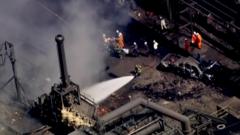A thorough investigation is underway to uncover the reasons behind the tragic crash of Air India Flight AI171 shortly after takeoff. Speculations include possible engine failure, bird strikes, and flap deployment issues, with input from aviation experts as authorities seek answers.**
Analyzing the Tragic Crash of Air India’s Flight AI171 Shortly After Takeoff**

Analyzing the Tragic Crash of Air India’s Flight AI171 Shortly After Takeoff**
Experts explore the potential causes behind the crash of Air India Flight AI171, which went down just moments after departing from Ahmedabad, resulting in significant casualties.**
Air India Flight AI171 met a tragic fate shortly after takeoff from Sardar Vallabhbhai Patel International Airport in Ahmedabad, resulting in the loss of 241 lives on board and additional casualties on the ground. The Boeing 787-8 Dreamliner crashed just 1.5 km from the runway, marking the first fatal incident for this aircraft model since its introduction in 2011. The full details surrounding the crash remain unclear, pending an extensive investigation supported by Indian, US, and UK aviation experts.
The experienced flight crew, comprising Captain Sumeet Sabharwal and co-pilot Clive Kundar, faced immediate adversity as the aircraft took off at 13:39 local time. Eyewitness accounts reveal that a mayday call was issued shortly after takeoff, but there was no following communication from the aircraft. Reports from the sole survivor indicated a loud bang as the plane struggled to climb, leading to footage showing the aircraft dangerously low over residential areas before it ultimately crashed.
Aviation experts have suggested multiple potential causes for the disaster. Among them, a rare double engine failure has raised eyebrows, an event described as almost inconceivable, recalling the 2009 "Miracle on the Hudson" incident when an Airbus A320 lost power after a bird strike. Investigators are set to examine the aircraft's black box, flight data, and wreckage for clues.
Bird strikes have also been proposed as a reason for the crash, particularly due to the frequent incidents reported at Ahmedabad airport. The region recorded 462 bird strikes over five years, making bird interactions a significant concern for pilots in the area. However, experts noted the rarity of a bird strike resulting in complete engine failure unless both engines are affected.
Another angle being investigated involves the aircraft's flaps, which are crucial for achieving lift during takeoff. There are questions as to whether the flaps were properly set, with extreme temperatures at the time increasing the demands for optimal settings. Experts have stated that failure to deploy flaps correctly could lead to disastrous consequences in such conditions.
As investigators delve deeper into the potential factors that led to this calamitous event, the aviation world waits for answers and further insight into the tragic demise of Flight AI171. With ongoing support from manufacturers and safety authorities, the focus remains on enhancing safety measures to prevent similar incidents in the future.



















